Local Students Learn About DNA During
I-STEM's DNA Day Outreach
May 3, 2016
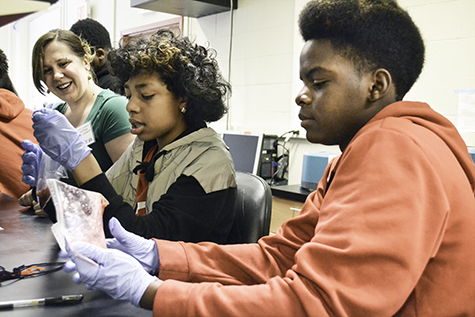
MCB grad student Michelle Goettge (left) supervises two Champaign middle school students as they extract DNA from strawberries..
A group of 29 mostly underrepresented local students from Urbana High School and several Champaign middle schools and high schools visited campus on Friday, April 29 to participate in "DNA Applications: Interdisciplinary Perspectives for STEM Careers."Hosted by the I-STEM Education Initiative as part of the National Institutes of Health (NIH)-sponsored National DNA Day activities, the event, primarily via hands-on activities and tours, introduced the local students to DNA, some DNA research done on campus, and some careers that deal with DNA. Students were also encouraged they, too, could go to college, and were apprised of several resources available to help them achieve that goal.
I-STEM Director Luisa Rosu emphasized that she and her staff emphasized the recruitment of underserved students to the event: "First, let me just tell a bit about who the students were," explains Rosu. "Actually this is probably the most, most important part in terms of impact. So we had high school students, minorities, from Urbana and we had middle schoolers, which was a surprise in a sense, but actually it turned out that these kids did grad student experiments. Which is really, really cool and I’m very excited."
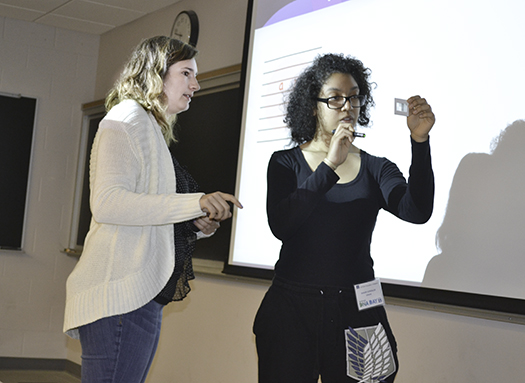
CPLC Postdoc Caitlin Davis shows an Urbana High student how diffraction works.
To begin the day’s activities, students received a brief Introduction to DNA by Caitlin Mearns Marlatt Davis, a Center for the Physics of Living Cells (CPLC) postdoc, who presented the historical discoveries of DNA, including an introduction to Rosalind Franklin, who played a crucial role in determining the structure of DNA using X-ray diffraction.
Students then participated in a series of three hands-on activities planned and led by CPLC's Caitlin Davis and Katie Molohon Hess, CPLC's K-12 Education Postdoctoral Fellow, as well as MCB (School of Molecular & Cellular Biology) graduate students who are members of a newly formed graduate student association, the MCBees.
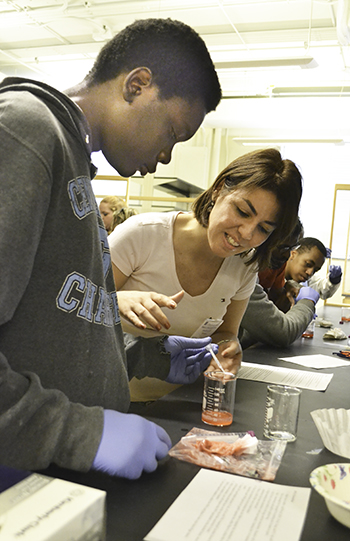 A DNA Day participant extracts DNA from strawberries as an Illinois grad student (center) watches nearby.
A DNA Day participant extracts DNA from strawberries as an Illinois grad student (center) watches nearby.According to Molohon, the idea was to give students "an overview of how DNA was discovered and the order in which it was discovered. So we started with isolation and moved to DNA diffraction, which talked about the structure, and then we could model the structure using the yarn." Following are the three activities, and the main thing students were to learn about DNA:
1. Extracting DNA from strawberries: DNA is fibrous.
2. Simulating DNA Diffraction: DNA is helical.
3. DNA Modeling: DNA forms supercoils.
In the "Extracting DNA" activity, students mashed strawberries up, then slowly added isopropanol to extract the DNA.
It didn't go like clockwork. A few of the students encountered some problems...just like real researchers do.
"I saw a number of students that maybe didn’t get the DNA right in the beginning," explains CPLC's Katie Molohon, "and they added more isopropanol, and they were able to extract their DNA. Even though they didn’t get it the first time, their graduate students explained to them, ‘Well, why don’t you try adding a little more isopropanol?' and they did, and they saw DNA. So they were able to trouble shoot, problem solve, work together in teams."

A local middle school student uses a laser to simulate DNA diffraction.
In the “Simulating DNA Diffraction” activity, the students used laser pointers to simulate Rosalind Franklin's key experiment, then observed the diffraction patterns that led to today's familiar image of the genetic material inside all of us.
The third activity, DNA Modeling, involved taking different strands of colored yarn and weaving them together, then folding them over into a tiny ball, to illustrate how DNA is able to fit into a tiny space.
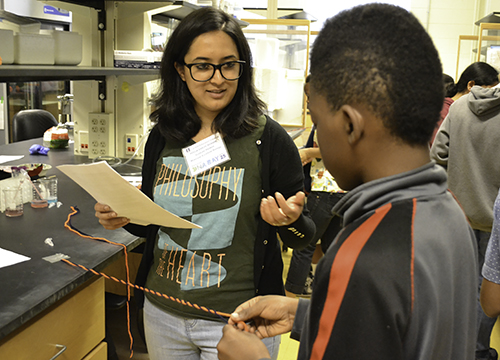
An MCB grad student, Pooja Agashe, discusses with a local middle school student how DNA can fold to fit into such a small space.
"It was a real mystery how you could have something that small," explains Molohon, "code, the genetic material but also be something small but very long; how does the cell use all that genetic material at one time. We basically talked about how it can fold, and how it is inside."
During lunch, there were talks about how to apply for admission to Illinois, and resources available to help students navigate challenges they might encounter in getting a college education. For instance, Curtis Blanden, from the Office of Minority Student Affairs, gave a presentation about TRIO Programs.
According to Blanden, he was trying to convey to the students: "the understanding that they will all have obstacles in life but, through people and programs offered excuses can be eliminated and dreams can become a reality."
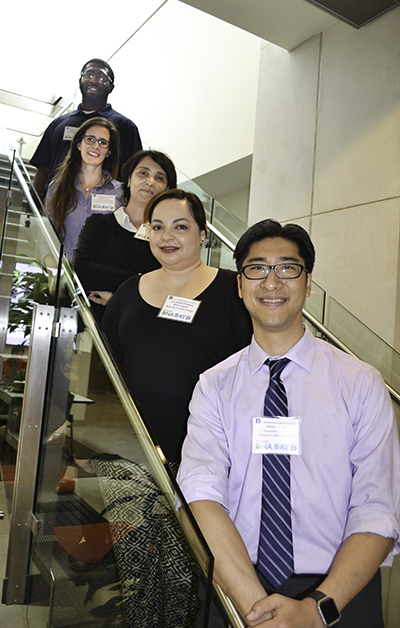
Top left to bottom right: Curtis Blanden, the Office of Minority Student Affairs; Courtney Cox, IGB Outreach Manager; Luisa Rosu, I-STEM Director; Alejandra Stenger, MCB Merit Program Director; and Daniel Wong, Associate Director of the Educational Equity Programs office.
Blanden indicates that he hopes he helped the students "understand that TRIO programs at the University of Illinois at Urbana-Champaign (Academic Talent Search, Upward Bound, Student Support Services, Ronald E. McNair Scholars Programs) can have an impact in their lives as they transition from middle school to high school, and high school to college/career."
Blanden hopes "something that was said entered their thought process to influence their understanding that you can 'Turn Roadblocks Into Opportunities.'"
Also giving a brief presentation during lunch was Alejandra Stenger, MCB Merit Program Coordinator, who discussed how her program is a resource for students in biology, chemistry, and math.
Also present was Daniel Wong from the Graduate College's Educational Equity Programs office, who spoke on "Mentors, Opportunities, and Culture."
Wong's hope was that students would take away, "the importance of mentorship in preparing for a STEM career, particularly from faculty members and graduate students in their prospective fields of interest." Wong also shared with students "about the opportunities available to them as Illinois students, as well as the opportunities available nation-wide for students from traditionally underrepresented populations." Finally, he addressed "the 'culture' of research at an R1 institution like Illinois and how they can best position themselves to be successful here, or at a comparable institution."
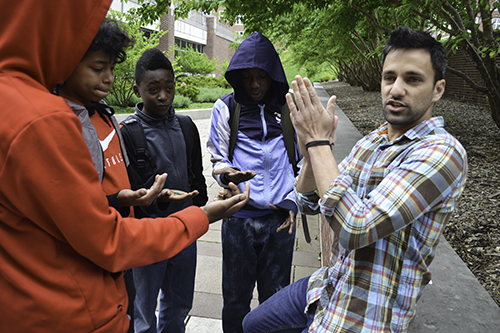
Above: Brian San Francisco (right) does a hands-on activity with several Champaign middle school students to illustrate how easily disease can be spread through touch.
Below: a DNA Day participant who has just shaken hands with one of the "originally infected" students discovers first-hand how easily disease can spread.
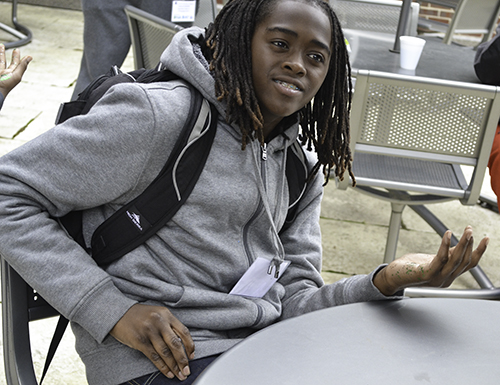
During this section, Wong also planted a seed, suggesting to the students that the advanced degree, Ph.D, was something they could attain to, then introduced some programs from his office, including SROP (Summer Research Opportunities Program), and the SPI (Summer Pre-Doctoral Institute), which could help them achieve those goals. Wong also held a question-and-answer session in order to answer any questions the students had about Illinois or pursuing a STEM career.
Next on the agenda was a hands-on activity related to health research being done at the Institute of Genomic Biology (IGB). Brian San Francisco, an IGB Postdoctoral Fellow in the Mining Microbial Genomes Theme, and Courtney Cox, IGB's Outreach Activities Manager, led an activity designed to show how easily infectious diseases (both bacterial and viral) can be spread via one's hands.
During the activity, which could be described as the epitome of a "hands-on" activity, student volunteers' hands were liberally sprayed with Pam, then sprinkled with glitter. The volunteers were then encouraged to shake hands with other students to demonstrate how easily disease can be spread through touch. As part of the activity, students also had the opportunity to see a worksheet containing microscopic images of different viruses and bacteria.
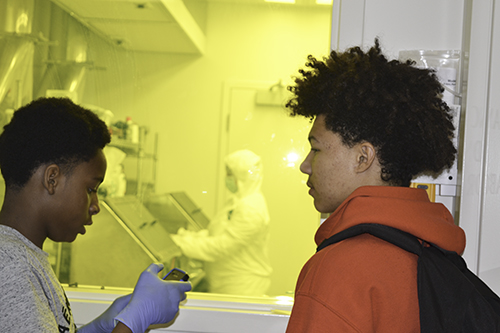
Two middle school students appreciate the Ancient DNA clean room lab during the tour of IGB.
In the afternoon, I-STEM’s young visitors took a tour of the IGB organized by Courtney Cox. The tour highlighted the collaborative research done at the IGB and the Core Facilities that house its state-of-the-art microscopes.
Following the tour, students were exposed to a presentation about Ancient DNA with Professor Ripan Malhi of Anthropology, along with several of the graduate students in his lab.
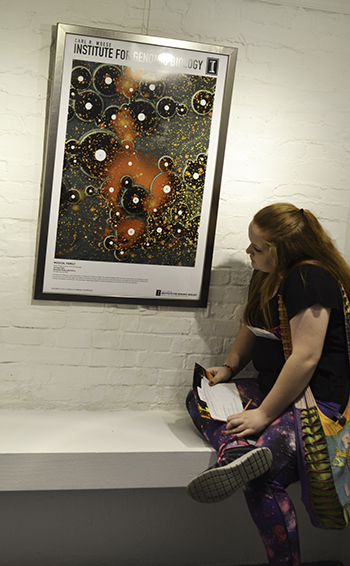
An Urbana High School student examines "Musical Family" produced by Jinrong Chen on a Zeiss Stereolumar v12 microscope in the Hyunjoon Kong Laboratory. The student is reading the description of the piece of art: "Ultrasound imaging is used extensively in diagnostic medicine...The resulting image quality leads to improved diagnosis of cancers and vascular diseases."
The final activity for the day was a visit to IGB’s Art of Science Exhibit held in downtown Champaign, Illinois, also led by Courney Cox. The Art of Science is an exhibition comprised of images from IGB research addressing significant problems in the environment, medicine, and energy use and products. Images are selected to highlight the beauty and fascination encountered in daily scientific endeavors.
"Scientific research can sometimes feel far removed from the joys and struggles of our daily lives. The aim of the Art of Science program, created by the Carl R. Woese Institute for Genomic Biology at the University of Illinois in 2011, is to make science more applicable by presenting it to the public in a way that is visually pleasing and intense." – Art of Science Image Guide 2016
According to I-STEM director Rosu, the goal of the event was to expose students not only to DNA, but to careers that involve the use of DNA. "I hope that at the end of the day," she explains, "all the kids will know how many possibilities are out there to work with DNA in so many ways."
Even more importantly, Rosu explains that the overarching goal of the event was to expose the youngsters to STEM: More than anything, I really, really hope that they will explore and get more comfortable with the idea of working in STEM areas. And I think they are ready, because they worked in a lab for three hours, and they had the chance to interact with graduate students, with post docs, and with faculty members, and that’s something that I hope made them more comfortable to work with."
More than anything Rosu hopes the day's activities got the students excited about science: "There were many aspects unexpected that captured their attention...I hope that they will leave at the end of the day, and they will say “Wow, that was something!” And later they will think about this day, I hope so."
Story and photographs by Elizabeth Innes, Communications Specialist, I-STEM Education Initiative.
More: 8-12 Outreach, I-STEM Initiatives, Underserved Minorities, Urbana High School, 2016













.jpg)
















